Crucifixion
Introduction
On the day before the Sabbath the Romans brought Jesus to the place in Hebrew called Golgotha, which translated means, Place of a Skull. They crucified Him. The four Roman soldiers divided up His garments among themselves, casting lots for them, to decide what each should take. John 19:17-18; Luke 23:33-34.
The enemies of Jesus assembled around His cross, taking grim pleasure in seeing Him crucified. Passing by, they taunted Him, and hurled insults and abuse, wagging their heads, and saying, “You who were going to destroy the temple and rebuild it in three days, save Yourself, and come down from the cross!” The chief priests along with the scribes also mocked Him among themselves, saying, “He saved others; He cannot save Himself. Let this Christ, the King of Israel, now come down from the cross, so that we may see and believe!” Matt 27:39-43; Mark 15:29-32; Luke 23:35-37.
The mockers about the cross unwittingly declared the test that would validate the claims of Jesus. They said, “...that we may see and believe.” But merely coming down from the cross was not enough. Jesus intended to rise from the dead that they “...may see and believe.”
The importance of the Resurrection cannot be overstated. It is the foundation of Christianity, and the only guarantee to mankind of a life hereafter. As the Apostle Paul said, “...if Christ has not been raised, your faith is worthless; you are still in your sins.” I Corinthians 15:17.
Review
1. The Romans crucified Jesus at a place called ____________________.
2. The Roman soldiers cast lots for the ________________ of Jesus.
3. His enemies referred to Jesus as ______________, the ___________ of ____________.
4. The resurrection is the ________________________ of Christianity.
The Death on the Cross
People who refuse to believe in the resurrection of Christ base their skepticism on several different explanations of the facts. The Jewish authorities argued that the disciples came and stole the body away from the tomb. Others said that the disciples lost the way to the tomb, and thus became confused. In the early years of the 19th Century a Rationalist by the name of Venturini argued that Jesus did not truly die upon the cross, but swooned. His explanation says that the disciples buried Jesus in the tomb, but that he later revived in the cool restfulness of the tomb and left.
There are obvious difficulties with these and other explanations of the resurrection. Those difficulties become evident when the plain facts of the gospel record are laid beside them.
The Crucifixion
The importance of the Resurrection must not be minimized. In his first letter to the Corinthians Paul stated the case bluntly,
1 Corinthians 15:13 But if there is no resurrection of the dead, not even Christ has been raised; 14 and if Christ has not been raised, then our preaching is vain, your faith also is vain. 15 Moreover we are even found to be false witnesses of God, because we witnessed against God that He raised Christ, whom He did not raise, if in fact the dead are not raised. 16 For if the dead are not raised, not even Christ has been raised; 17 and if Christ has not been raised, your faith is worthless; you are still in your sins.
Owing to various adjustments in the calendar, the years of Jesus’ birth and death remain controversial. However, it is likely that Jesus was born in either 4 or 6 BC, and died in 30 AD. During the Passover observance in 30 AD, the Last Supper would have been observed on Thursday, April 6 [April on our calendar corresponds approximately to the Jewish month of Nisan; the Last Supper fell on the 13th day of the month of Nisan]. Jesus would have been crucified on Friday, April 7 (Nisan 14).
The Health of Jesus
The rigors of Jesus’ ministry (that is, traveling by foot throughout Palestine) would prove to us that he had no major physical illness , nor did he have a weak bodily constitution. Accordingly, it is reasonable to assume that Jesus was in good physical condition before his walk to Gethsemane. However, during the 12 hours between 9 PM Thursday and 9 AM Friday, he suffered great emotional stress (as evidenced by hematidrosis[1] ), abandonment by his closest friends (the disciples), and a physical beating (after the first Jewish trial). Also, in the setting of a traumatic and sleepless night, he had been forced to walk more than 2.5 miles (4.0 km.) to and from the sites of various trials. These physical and emotional factors may have rendered Jesus particularly vulnerable to the adverse effects of scourging, including intense pain and blood loss.
Gethsemane.
Jesus suffered great mental anguish at Gethsemane. After Jesus and his disciples had observed the Passover meal in an upper room in a home in southwest Jerusalem, they traveled to the Mount of Olives, northeast of the city. At nearby Gethsemane, Jesus, apparently knowing that the time of his death was near, suffered great mental anguish, and, as described by the physician Luke, his sweat became like blood.
Although it is a rare phenomenon, bloody sweat (hematidrosis or hemohidrosis) may occur in highly emotional states or in persons with bleeding disorders. As a result of hemorrhage into the sweat glands, the skin becomes fragile and tender. Luke’s description supports the diagnosis of bloody sweat rather than brown or yellow-green sweat (eccrine chromidrosis), or blood oozing from the palms or elsewhere (stigmatization). Although some authors have suggested that the bloody sweat produced a decrease in the volume of circulating blood (hypovolemia), medical doctors agree with Bucklin that Jesus’ actual blood loss probably was minimal. However, in the cold night air, it may have produced chills.[2]
Scourging
Scourging, or flogging, was a legal preliminary to a Roman execution.[3] Usually, two soldiers (lictors) performed the scourging, using a short whip called a flagrum, or flagellum. It was a whip with several single, or braided leather thongs of different lengths. Small iron balls, or sharp pieces of sheep bones were tied in the thongs. (Fig. 1)
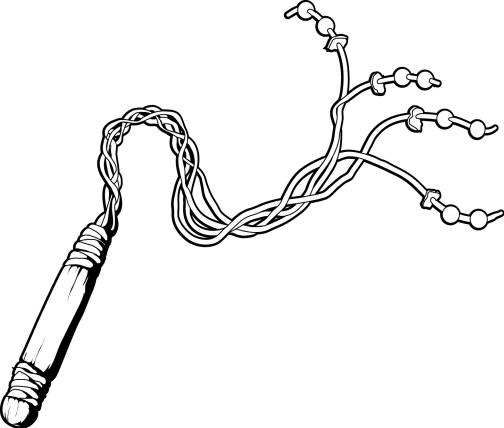
Fig. 1. A flagrum, or flagellum.
The soldiers stripped the victim of his clothing, and tied his hands to an upright post. They then flogged his back, buttocks, and legs to weaken the victim to a state just short of collapse and death. (Fig. 2) The intent of flogging was not to kill but to weaken the victim. Scourging caused these injuries: contusions, deep cuts, and torn skeletal muscles. The victim suffered intense pain. Blood loss caused circulatory shock. Survival on the cross in many cases depended on the severity of blood loss.
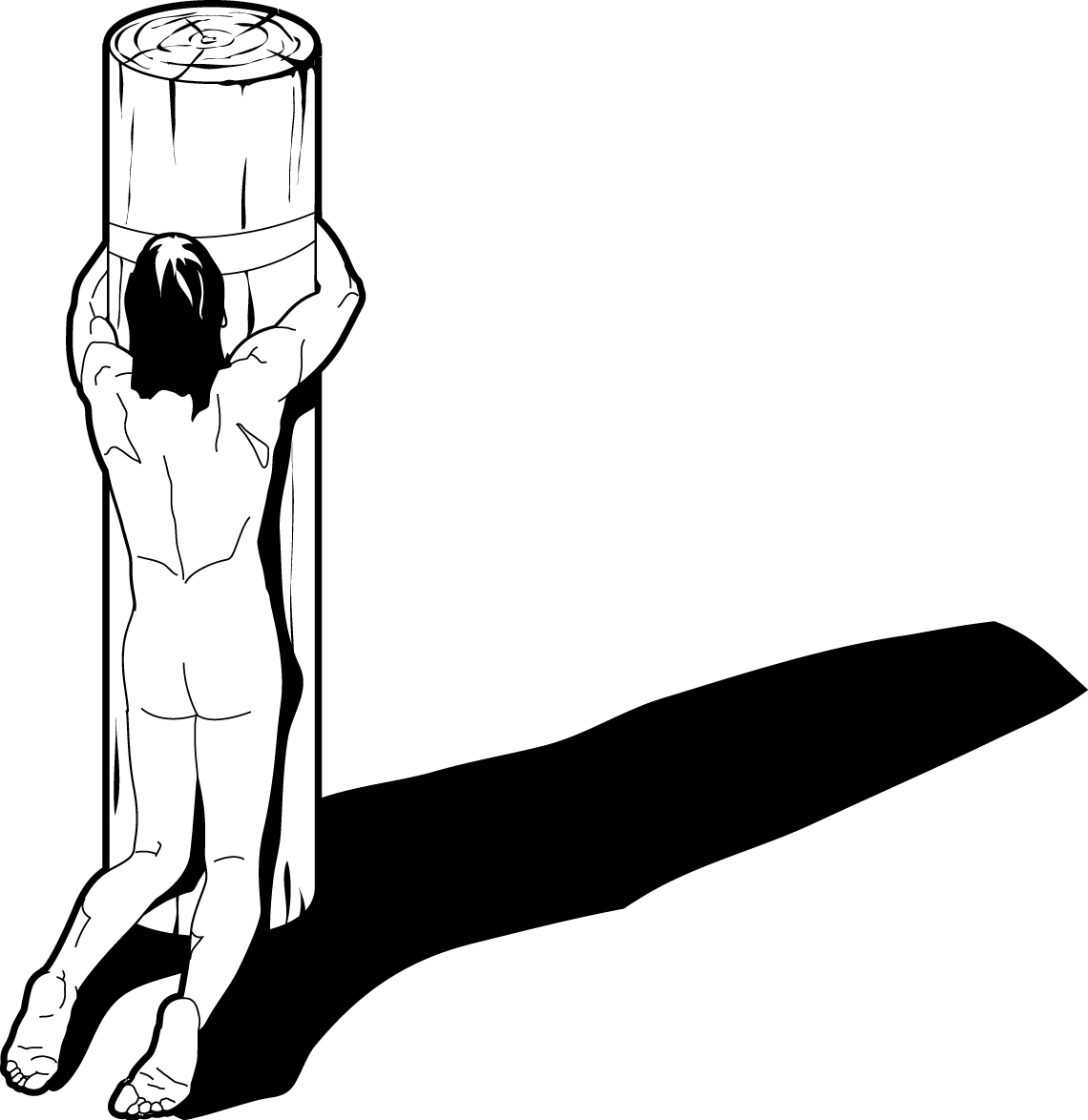
Fig. 2. A victim of scourging, stripped and tied to an upright post.
Luke wrote,
Luke 23:13 And Pilate summoned the chief priests and the rulers and the people, 14 and said to them, “You brought this man to me as one who incites the people to rebellion, and behold, having examined Him before you, I have found no guilt in this man regarding the charges which you make against Him. 15 “No, nor has Herod, for he sent Him back to us; and behold, nothing deserving death has been done by Him. 16 “I will therefore punish Him and release Him.”
John wrote,
John 19:1 Then Pilate therefore took Jesus, and scourged Him. 2 And the soldiers wove a crown of thorns and put it on His head, and arrayed Him in a purple robe; 3 and they began to come up to Him, and say, “Hail, King of the Jews!” and to give Him blows in the face.
Matthew wrote,
Matthew 27:24 And when Pilate saw that he was accomplishing nothing, but rather that a riot was starting, he took water and washed his hands in front of the multitude, saying, “I am innocent of this Man’s blood; see to that yourselves.” 25 And all the people answered and said, “His blood be on us and on our children!” 26 Then he released Barabbas for them; but after having Jesus scourged, he delivered Him to be crucified. 27 Then the soldiers of the governor took Jesus into the Praetorium and gathered the whole Roman cohort around Him. 28 And they stripped Him, and put a scarlet robe on Him. 29 And after weaving a crown of thorns, they put it on His head, and a reed in His right hand; and they kneeled down before Him and mocked Him, saying, “Hail, King of the Jews!” 30 And they spat on Him, and took the reed and began to beat Him on the head. 31 And after they had mocked Him, they took His robe off and put His garments on Him, and led Him away to crucify Him.
The Cross
The upright post used for crucifixion, in Latin called the stipes, was generally, permanently fixed in the ground at the site of execution. (Fig. 3, below) Authorities frequently located the stipes outside the city walls. The victim carried the crossbar, or patibulum, to the site of crucifixion where the executioners would secure the crossbar to the upright post (Fig. 4). In the case of the Tau cross (as shown in Fig. 3), this was accomplished by means of a mortise and tenon joint, with or without reinforcement by ropes. To prolong the crucifixion process, a horizontal wooden block or plank, serving as a crude seat (sedile or sedulum), often was attached midway down the stipes. Only very rarely, and probably later than the time of Christ, was an additional block (suppedaneum) employed for transfixion of the feet.

Fig. 3. The Tau Cross, named Tau because it resembled the Greek letter t. Archaeological evidence indicates that this is probably the type of cross on which the Romans crucified Jesus.
 Fig. 4 Victim carrying the crossbar or patibulum.
Fig. 4 Victim carrying the crossbar or patibulum.
At the site of execution, by law, the executioners gave the victim a bitter drink of wine mixed with myrrh (gall) as a mild analgesic (a pain reliever). [4] Jesus refused this drink. Mark 15:23.
Crucifixion probably began first among the Persians. Alexander the Great introduced the practice to Egypt and Carthage, and the Romans appear to have learned of it from the Carthaginians. Although the Romans did not invent crucifixion, they perfected it as a form of torture and capital punishment that was designed to produce a slow death with maximum pain and suffering. It was one of the most disgraceful and cruel methods of execution and usually was reserved only for slaves, foreigners, revolutionaries, and the vilest of criminals. Roman law usually protected Roman citizens from crucifixion, except perhaps in the case of desertion by soldiers.
In its earliest form in Persia, the executioners either tied the victim to a tree or impaled him on an upright post, usually in a manner that kept the guilty victim’s feet from touching the ground. Only later did they use a true cross. An upright post (stipes) and a horizontal crossbar (patibulum) characterized the cross, and it had several variations (See Appendix, Table, Types of Crosses). Although archaeological and historical evidence strongly indicates that the Romans in Palestine preferred the low Tau cross at the time of Christ (Fig. 3, above), crucifixion practices often varied in a given geographic region and in accordance with the imagination of the executioners. The Latin cross and other forms also may have been used.
A complete Roman military guard, headed by a centurion, led the processional to the site of crucifixion. One of the soldiers carried a sign (titulus) on which they wrote the condemned man’s name and the crime for which they executed him (Fig 5, below). At the site of crucifixion the titulus would be attached to the top of the cross.

Fig. 5 The titulus, carried by a Roman soldier and attached to the cross, would have appeared similar to the drawing above. The words are in three languages: Hebrew, Latin, and Greek, and mean, "Jesus the Nazarene, King of the Jews."
Jesus carried His own cross. John wrote,
John 19:17 They took Jesus therefore, and He went out, bearing His own cross, to the place called the Place of a Skull, which is called in Hebrew, Golgotha. 18 There they crucified Him, and with Him two other men, one on either side, and Jesus in between.
It was customary for the condemned man to carry his own cross from the flogging post to the site of crucifixion. In Jerusalem the site was outside the city walls. The condemned was usually naked, unless this was prohibited by local customs. Since the weight of the entire cross was probably well over 300 lb. (136 kg), the victim carried only the crossbar (Fig. 4). The patibulum, weighing 75 to 125 lb. (34 to 57 kg), was placed across the nape of the victim’s neck and balanced along both shoulders. Usually, the executioners tied the victim’s outstretched arms to the crossbar.
That Jesus had suffered greatly under the flogging may be inferred from his inability to bear the crossbar all the way to the place of crucifixion. John 19:17; Matt 27:32.
Luke wrote,
Luke 23:26 And when they led Him away, they laid hold of one Simon of Cyrene, coming in from the country, and placed on him the cross to carry behind Jesus.
Matthew wrote,
Matthew 27:32 And as they were coming out, they found a man of Cyrene named Simon, whom they pressed into service to bear His cross.
The Method
Matthew 27:33 And when they had come to a place called Golgotha, which means Place of a Skull, 34 they gave Him wine to drink mingled with gall; and after tasting it, He was unwilling to drink. 35 And when they had crucified Him, they divided up His garments among themselves, casting lots; 36 and sitting down, they began to keep watch over Him there. 37 And they put up above His head the charge against Him which read, “THIS IS JESUS THE KING OF THE JEWS.”
They threw the victim to the ground on his back, with his arms outstretched along the patibulum. His hands could be nailed or tied to the crossbar, but the Romans apparently preferred nailing.
The archaeological remains of a crucified body, found in an ossuary near Jerusalem and dating from the time of Christ, indicate that the nails were tapered iron spikes approximately 5 to 7 in. (13 to 18 cm) long with a square shaft 3/8 in. (1 cm. ) across. Furthermore, ossuary findings and the Shroud of Turin have documented that the nails commonly were driven through the wrists rather than the palms (Fig. 6, below).
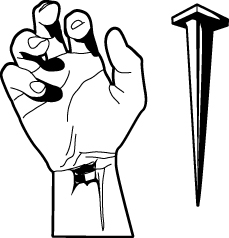
Fig. 6 Nail driven through wrist.
After both arms were fixed to the crossbar, the patibulum and the victim, together, were lifted onto the stipes. On the low cross, four soldiers could accomplish this relatively easily. However, on the tall cross, the soldiers used either wooden forks or ladders. Next, the feet were fixed to the cross either by nails or ropes. Ossuary findings and the Shroud of Turin suggest that nailing of the feet was the preferred Roman practice. Although the feet could be fixed to the sides of the stipes or to a wooden footrest (suppedaneum), they usually were nailed directly to the front of the stipes (Fig 7, below). To accomplish this, flexion of the knees may have been quite prominent, and the bent legs may have been rotated laterally.
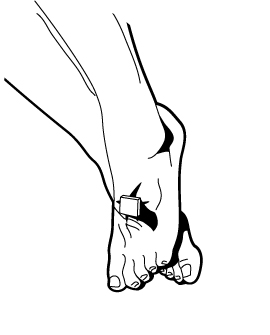
Fig. 7 Nail driven through feet.
When they had completed the nailing, they attached the titulus to the cross, by nails or cords, just above the victim’s head. The soldiers, and the civilian crowd, often taunted and jeered the condemned man, and the soldiers customarily divided up his clothes among themselves.
The length of survival generally ranged from three or four hours to three or four days, and appears to have been inversely related to the severity of the scourging. However, even if the scourging had been relatively mild, the Roman soldiers could hasten death by breaking the legs below the knees (crucifragium or skelokopia).
Not uncommonly, insects would burrow into the open wounds, or the eyes, ears, and nose of the dying and helpless victim. Birds of prey would sometimes tear at these sites. In actual practice, it was customary to leave the corpse on the cross to be devoured by predatory animals. However, by Roman law, the family or friends of the victim could take the body down for burial. To do this they first had to obtain permission from the Roman judge. (See Matt. 27:58; Luke 23:50-53)
The Intent
The intent of crucifixion was to cause suffering and death. Crucifixion was capital punishment in its cruelest form. The Romans did not intend that any victim would survive the cross. To ensure that the victims did not survive, the Romans assigned soldiers to perform the execution and to remain at the site until they could verify that death had occurred. Crucifixion had the following characteristics:
• Design: slow death, maximum pain, suffering
• Regard: disgrace, cruel
• Persian method: tied to tree, impaled on post
• Condemned carried his own cross
• Roman: led to site by a guard, with centurion
• stipes located permanently at the site
• Victim given bitter drink by law
• Wrists nailed to cross bar first
• patibulum and victim lifted to top of stipes, feet nailed
• Survival usually 3 to 4 hours
• Death hastened by breaking the legs
Death on the Cross
Since the authorities did not intend that the victim survive crucifixion, the body was not released to the family until the soldiers were sure that the victim was dead. By custom, one of the Roman guards would pierce the body with a sword or lance. Traditionally, this has been regarded as a spear wound to the heart through the right side of the chest—a fatal wound probably taught to most Roman soldiers. (Fig. 8, below) The Shroud of Turin documents this form of injury. Moreover, the standard infantry spear, which was 5 to 6 ft (1.5 to 1.8 m) long, could easily have reached the chest of a man crucified on the customary low cross.
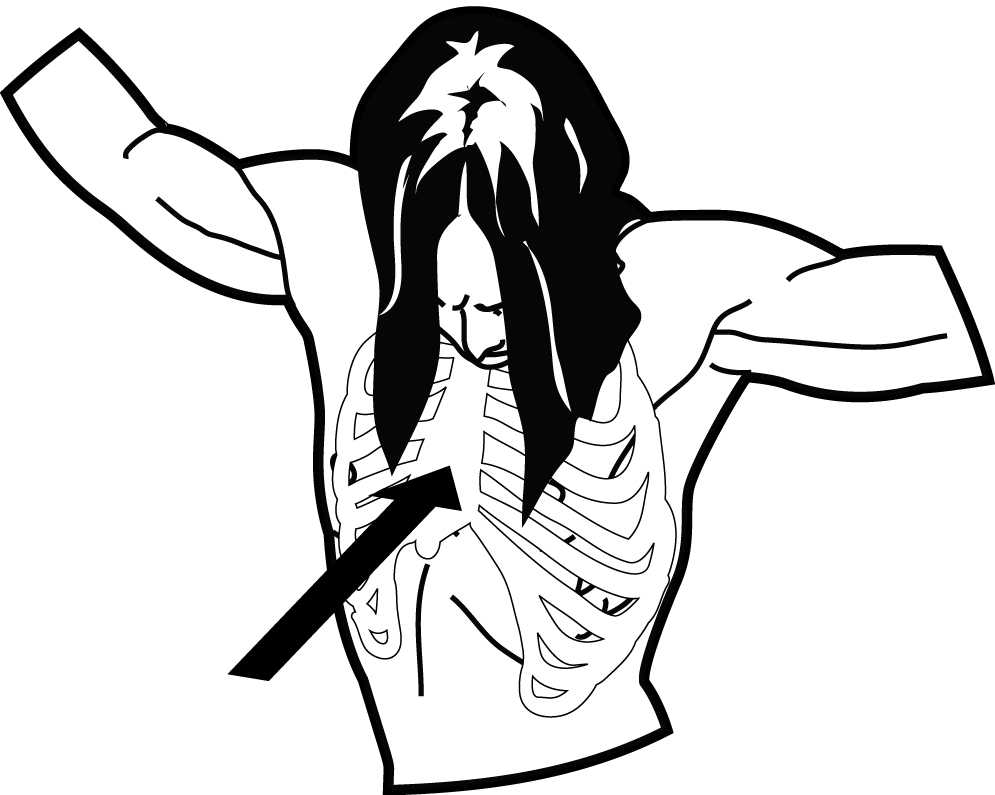
Fig. 8 Spear direction for fatal wound.
Jesus’ Last words.
Mark 15:33 When the sixth hour came, darkness fell over the whole land until the ninth hour. 34 And at the ninth hour Jesus cried out with a loud voice, … “My God, My God, why has thou forsaken Me?”
Mark says,
Mark 15:37 And Jesus cried out with a loud voice, and breathed His last. But Luke and John record what He cried out.
The Scriptures say,
Luke 23:46 And when Jesus had cried out with a loud voice, He said, “Father, ‘into Your hands I commit My spirit.’ ” Having said this, He breathed His last.
And He said,
John 19:30 “It is finished!”
His words meant, everything has been accomplished which by the appointment of the Father as revealed in the Scriptures I must do and bear. [5]
Witnesses to His death
Gospel writers record his death in this way,
John 19:30 He bowed His head, and gave up His spirit.
Mark 15:39 And when the centurion, who was standing right in front of Him, saw the way He breathed His last, he said, “Truly this man was the Son of God!”
Women who knew him were present to see his crucifixion
Matthew 27:55 And many women who followed Jesus from Galilee, ministering to Him, were there looking on from afar, 56 among whom were Mary Magdalene, Mary the mother of James and Joses, and the mother of Zebedee’s sons.
The Jews, not wanting the bodies of the ones they had crucified to remain on the crosses until the Sabbath, went to Pilate. The Sabbath was a high day, a holy day. The Friday before the Sabbath was to the Jews the Day of Preparation for the Passover. So, on this Friday when Jesus was crucified, they went to Pilate, the governor, and asked that the legs of the ones crucified be broken—to hasten their deaths. It was not uncommon for the victims of crucifixion to remain alive, lingering on their crosses, for days. Pilate undoubtedly consented, for the soldiers came and broke the legs of the,
John 19:31 “... first man, and of the other man who had been crucified with Him; but coming to Jesus, when they saw that he was already dead, they did not break His legs; but one of the soldiers pierced His side with a spear, and immediately there came out blood and water.”
Mark wrote that Pilate confirmed his death by asking the centurion,
Mark 15:43 Joseph of Arimathea, a prominent council member, who was himself waiting for the kingdom of God, coming and taking courage, went in to Pilate and asked for the body of Jesus. 44 Pilate marveled that He was already dead; and summoning the centurion, he asked him if He had been dead for some time. 45 So when he found out from the centurion, he granted the body to Joseph.
Jesus died on the cross of Calvary
The testimony of the witnesses, and the records of history agree that Jesus was dead upon the cross. Consider:
Summary of evidence:
1) Jesus was scourged with a flagrum. This weakened Him. Scourging, or flogging, was a legal preliminary to a Roman execution. Usually, two soldiers performed the scourging, using a short whip called a flagrum or flagellum. It was a whip with several single, or braided leather thongs of different lengths. Small iron balls, or sharp pieces of sheep bones were tied in the thongs. The victim was stripped of his clothing. His hands were tied to an upright post. The back, buttocks, and legs were flogged to weaken the victim to a state just short of collapse and death.
2) Jesus carried His own cross. The weight of an entire cross exceeded 300 lb; therefore, in almost all cases the one who was crucified carried only the crossbar, called a patibulum. But the patibulum, alone, would have weighed 75 lb. to 125 lb. It was placed across the nape of the victim’s neck, and balanced along the shoulders. Usually, the arms were then tied to the patibulum. That Jesus had suffered greatly under the flogging may be inferred from his inability to bear the crossbar all the way to the place of crucifixion. John 19:17; Matt 27:32.
3) They nailed His hands and feet to the cross. The soldiers threw the victim on the ground on his back, with his arms outstretched along the crossbar. The Romans preferred at that time to nail the victim’s hands to the crossbar. Archaeological evidence indicates that the Romans used nails that were tapered iron spikes approximately 5 to 7 inches long, with a square shaft. They drove the nails through the wrists just above the heel of the hand. After they had nailed the victim’s hands to the crossbar, they then lifted the victim and crossbar to the post, or stipes. Romans would then have nailed the victim’s feet to the front of the stipes.
4) The centurion saw how He died. A complete Roman military guard accompanied victims of crucifixion to the site. A centurion commanded this guard. Pilate asked the centurion to verify that Jesus was dead. Mark wrote, Mark 15:44 Pilate marveled that He was already dead; and summoning the centurion, he asked him if He had been dead for some time. 45 So when he found out from the centurion, he granted the body to Joseph.
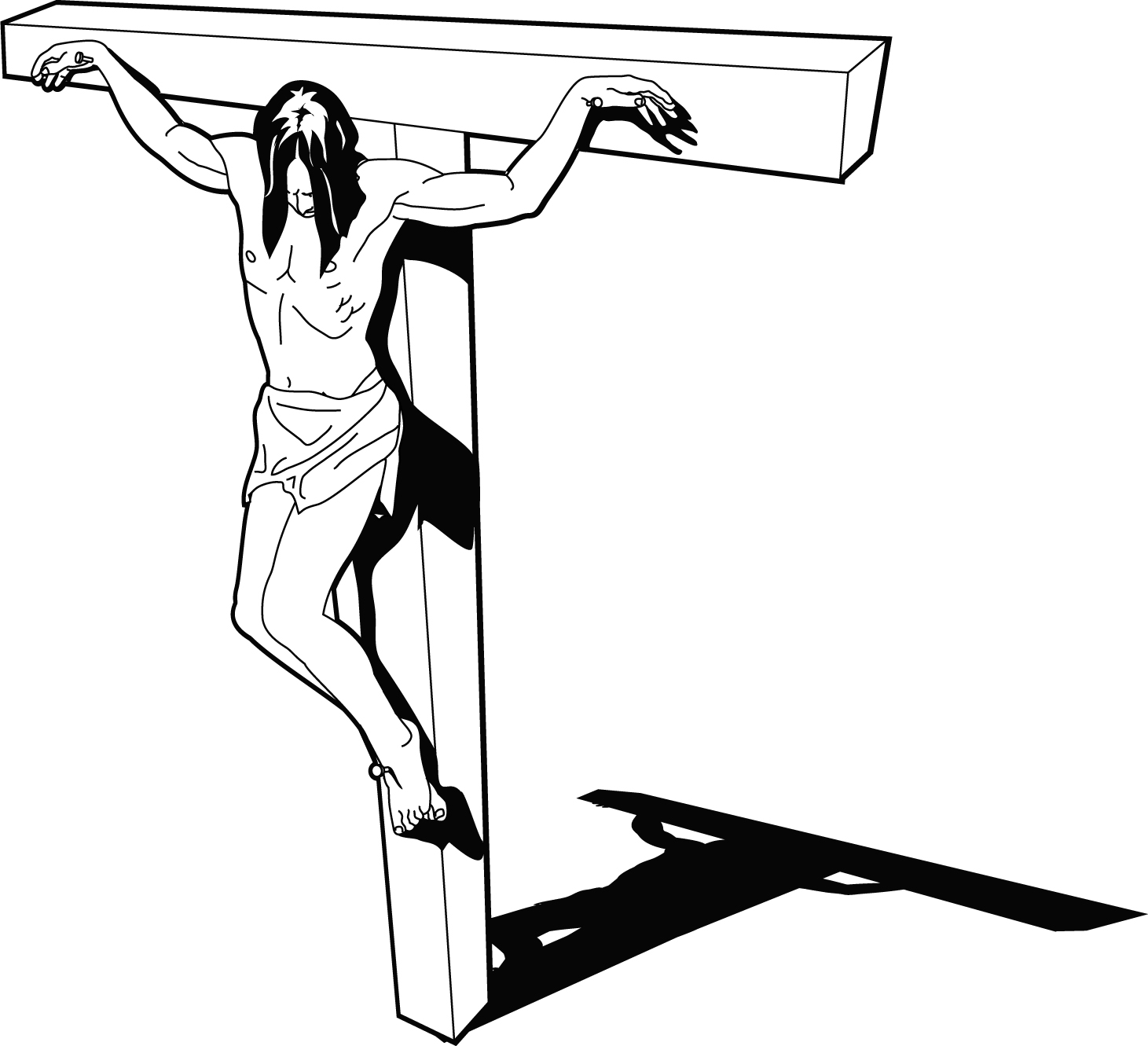
Fig. 9. The victim of crucifixion frequently died as a result of asphyxia.
5) The soldiers did not break Jesus’ legs because they saw that He was already dead. John wrote,
John 19:31 Therefore, because it was the Preparation Day, that the bodies should not remain on the cross on the Sabbath (for that Sabbath was a high day), the Jews asked Pilate that their legs might be broken, and that they might be taken away. 32 Then the soldiers came and broke the legs of the first and of the other who was crucified with Him. 33 But when they came to Jesus and saw that He was already dead, they did not break His legs.
6) A soldier pierced His side with a spear. John went on to say, John 19:34 But one of the soldiers pierced His side with a spear, and immediately blood and water came out. The Greek word used by John, pleura, meaning “side” clearly tells where the spear entered the body of Jesus.
7) Blood and water issued from the wound—indicating a rupture of the heart. Medical doctors believe the water was pleural and pericardial fluid which preceded the flow of blood. The accumulation of such fluid could easily result from cardiac rupture. The weight of medical evidence indicates that Jesus died before the thrust of the spear into his side. [6]
8) The disciple John saw Him crucified. John 19:26.
9) The women, who knew Him well, saw Him crucified.
John wrote,
John 19:25 Now there stood by the cross of Jesus His mother, and His mother’s sister, Mary the wife of Clopas, and Mary Magdalene.
Luke said,
Luke 23:49 But all His acquaintances, and the women who followed Him from Galilee, stood at a distance, watching these things. In verse 46 Luke says “He breathed His last.” And the acquaintances and women witnessed it.
10) His enemies believed He was dead. Matthew wrote,
Matthew 27:62 On the next day, which followed the Day of Preparation, the chief priests and Pharisees gathered together to Pilate, 63 saying, “Sir, we remember, while He was still alive, how that deceiver said, ‘After three days I will rise.’
Conclusion
The death of Jesus Christ upon the cross is certain. He died in the full physical sense of the word. Every witness confirms it, including His enemies.
Review - The death on the cross
1. The gospel of Mark says Jesus breathed His _________________.
2. The gospel of John says Jesus _______________ up His _____________.
3. A centurion who stood in front of Jesus saw how He _________________.
4. Many __________________ also saw Jesus crucified.
5. The Romans broke the legs of the ones crucified to hasten their _____________.
6. The Romans did not break the legs of Jesus. Why?
7. How did the soldier ensure the death of Jesus?
8. How did Pilate ensure himself of the death of Jesus?
9. Name two things that caused injury to Jesus or contributed to His suffering before His crucifixion.
10. How did the Romans attach Jesus to the cross.
11. Blood and water issuing from the spear wound indicated that Jesus suffered a ________________ of the _______________.
12. The disciples saw Jesus _________________________.
13. The enemies of Jesus believed He was ____________.
14. Jesus died in the _____________ _____________________ sense of the ________________.
_______________________________________________
1. Bloody sweat.
2. Journal of the American Medical Association, Mar. 21, 1986.
3. Jewish Law limited the lashes to 39, Vine: mastigovw. However, Romans punished Jesus. Maier, in Pontius Pilate a Biographical Novel, says it was the fustigatio, a milder form of beating than the severe scourging that precedes capital punishment. See Maier, p. 232. The inability of Jesus to carry the patibulum argues against the opinion of Maier. Further, Matthew and Mark use the Greek term: fragellwsa, indicating the use of the flagellum as a prelude to crucifixion. Matt. 27:26; Mk. 15:15.
4. Wine mixed with myrrh made a drug that was intended to dull the wits or senses.
5. Joseph Henry Thayer, Greek English Lexicon of the New Testament, telew .
6. Journal of the American Medical Association, Mar. 21, 1986, p. 1463.
